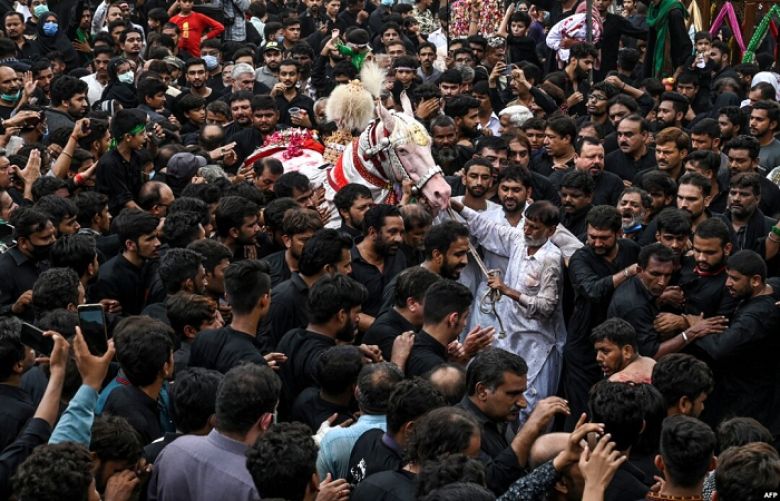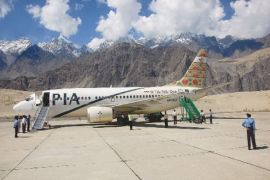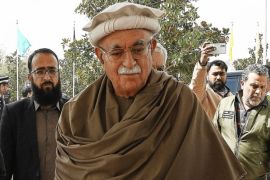Mourners across the country held processions on Muharram 9 to commemorate the martyrdom of Hazrat Imam Hussain (AS), his family, and his followers in Karbala.
The processions moved along their traditional, pre-determined routes in different cities and towns of the country, including Karachi, Islamabad, Lahore, Rawalpindi, Quetta, etc.
The mourners performed different rituals associated with the day.
Administrations in these cities and towns had put in place strict security measures to ensure that untoward incidents do not take place.
In different cities, all roads leading to the procession routes and sites were cordoned off using shipping containers and barbed wires.
Cellular phone services also remained suspended around the site of the processions.
Moreover, pillion riding was banned in most major cities and towns as a precaution.
Hundreds of security personnel had been deployed in different cities to ensure that processions were held peacefully. For this purpose, dozens of closed-circuit television (CCTV) cameras were installed along the routes.
Karachi
The central procession of Muharram 9 in Karachi started from Nishtarpark and after passing through traditional routes, culminated at Imambargah Hussainiya Iraniyan Kharadar.
The police and paramilitary Rangers had been deployed to perform security duties. More than 10,000 security personnel performed duties during Muharram processions.
Roads leading to the main processional routes in Karachi remained sealed.
Additionally, more than 3,000 traffic officers and officials performed duties to guide the traffic.
Mobile services saw a partial shutdown until 10:30 pm.
On the other hand, a temporary blood bank camp was also set up at Numaish Chowrangi to cater to the devotees joining the main procession of Muharram 9.
A significant number of pilgrims enthusiastically donated blood at the camp.
Quetta
The central procession of Muharram 9 started from Imambargah Nasir-ul-Azha at Megangi Road.
In a bid to prevent any untoward incidents, passageways along the procession route had been cordoned off, and buildings, shops, and business centres in the vicinity were sealed.
Citizens were urged to cooperate with security arrangements and follow designated routes.
Lahore
The main procession of Muharram 9 in Lahore were taken out from Pando street and will culminate at the same point after passing through Khema Sadat.
The procession was also monitored while traffic remained suspended along the routes where mourners passed through.
The traffic police had placed diversions to provide alternate routes for motorists.
The Metro Bus service also operated partially.
Several majlis were also held at different locations across the city.
Imam Bargah Atiya Ahl al-Bayt, Dr. Riyaz, led the procession with Shabiha Zuljanah.
The procession returned to Imambargah through Nicholson Road and conclude there.
A sabil had been arranged by Abdul Aleem Khan Foundation at Nicholson Road.
Islamabad
The mourners took out processions in the federal capital on the traditional routes.
As part of security measures, mobile phone services in the city remained partially suspended from 9am till midnight.
Rawalpindi
The main procession of Muharram 9 in Rawalpindi was taken out from Chittian Hattian with sabils installed across the route for the mourners.
The police stated that there were foolproof security arrangements on the procession routes.
Peshawar
The main procession of Muharram 9 in Peshawar was taken out from Sadar Imam Bargah Hussainiya Hall. Among the 62 Imambargahs, 20 had been declared as the most sensitive, and 42 as sensitive.
Peshawar SSP stated that more than 13,000 policemen were deployed for security.
Mobile service remained suspended in the city while 200 CCTV cameras had been installed to monitor the Imambargahs and processions.
Apart from this, the processions were also monitored through drone cameras.
Multan
The procession of Muharram 9 commenced from Mumtazabad and will culminate at its traditional point.
More than 2,000 security personnel were deployed to ensure the security of the mourners.
Further, the district administration had established a central control room to ensure heightened security measures.
As many as 180 CCTV cameras were installed along the route.
The control room monitored 101 sensitive processions and 325 sensitive gatherings in the city.







